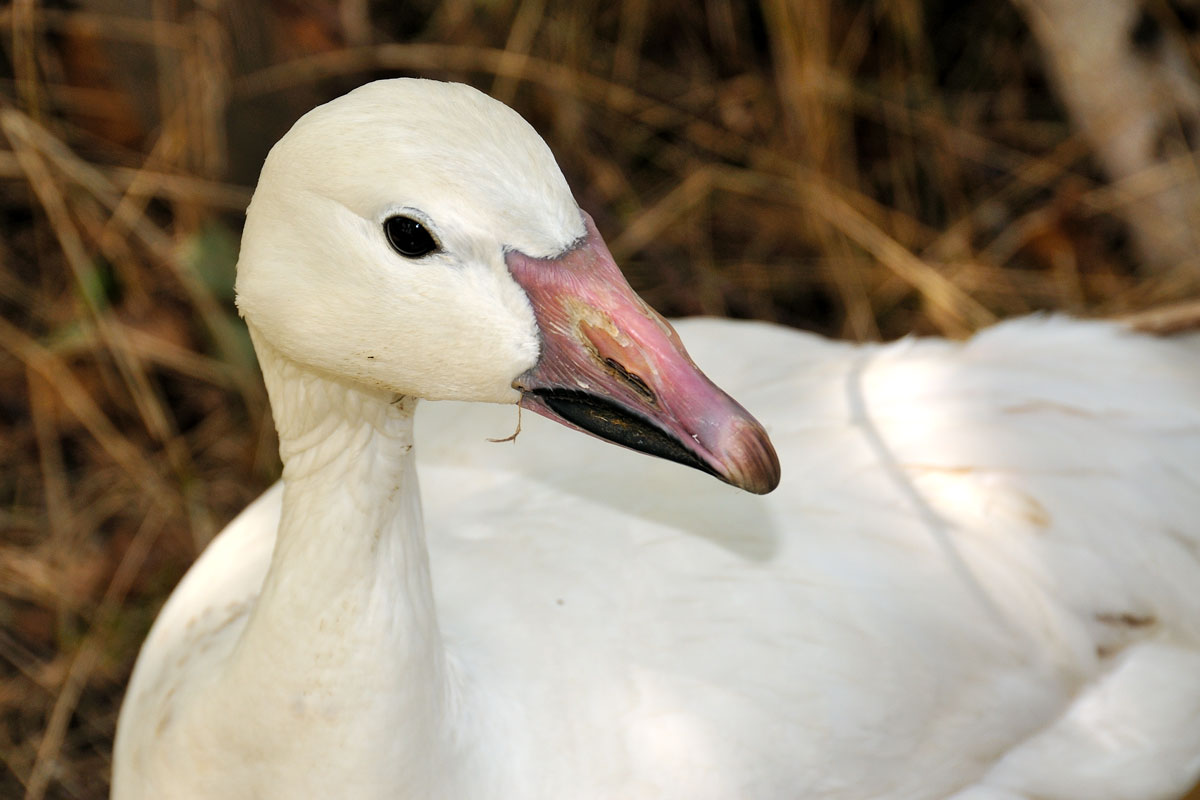Viewable


Bird
Location at the Zoo
Tundra Trek
Global Range
North America
Lesser snow goose
Chen caerulescens
Order: Anseriformes
Family: Anatidae
Genus: Anser
The lesser snow goose has two different appearances: white phase and blue phase. They are subsets of the same species. The two interbreed, and are found together throughout their range (colour phases are genetically determined). Phase members choose mates that resemble their parents. Individuals with mixed colour phase parents breed with either phase. The adult white phase is nearly all white except for black tipped wings; the legs and feet are red and the bill is pink surrounded by a patch of black skin called a "grinning patch" resembling a smile. The adult blue phase has a white head; the lower back and flanks are a bluish colour and the body ranges from very pale blue to almost white to very dark. The other colour features resemble the same as the white phase. Both phases have rusty orange faces and necks from the iron in the soil in which they feed. Males and females look alike.
Immature white phase geese have dirty white body and the wing tips are black. Immature blue phase geese are slate grey with little or no white, and legs and feet are red but paler than adults.
Goslings of white phase geese are yellow, and those of the blue phase are nearly black. Two month old birds of either phase are grey with black wing tips, although blue phase younger birds are generally a darker grey with light features on the chin and throat, also stained like adults. Goslings remain with grey patches of white beginning to show through until the following April or May.
Adult size
Weight: 2.3 kg (Males slightly larger than females
Length: 70 cm
Height: 64 to 79 cm
Wingspan: 43 cm
Immature white phase geese have dirty white body and the wing tips are black. Immature blue phase geese are slate grey with little or no white, and legs and feet are red but paler than adults.
Goslings of white phase geese are yellow, and those of the blue phase are nearly black. Two month old birds of either phase are grey with black wing tips, although blue phase younger birds are generally a darker grey with light features on the chin and throat, also stained like adults. Goslings remain with grey patches of white beginning to show through until the following April or May.
Adult size
Weight: 2.3 kg (Males slightly larger than females
Length: 70 cm
Height: 64 to 79 cm
Wingspan: 43 cm
Conservation Status: IUCN

Distribution
The lesser snow goose migrates over most of southern Canada, west of Quebec. Unlike most waterfowl, it nests in dense, large colonies (up to 2,000 pairs per square kilometre) over a vast area of the Canadian Arctic, as well as Wrangell Island in eastern Siberia and eastern Asia.Their nesting range lies along the west coast of Hudson Bay, Southampton Island, southern Baffin Island, the south coast of Queen Maud Gulf , Nunavut, and on Banks Island, NWT. Although only 20,000 to 40,000 birds winter in Canada, over 2 million birds nest in Canada’s north. The largest concentration of wintering birds occurs on the Fraser River Estuary. They arrive there from Wrangell Island (over 100,000 of them) in an amazing migratory spectacle.
Because lesser snow goose nesting colonies are spread over a huge tract of the Arctic, these geese use many different and lengthy migratory pathways, noisily flying in their undulating and shifting U shaped formation, composed of family groups, moving both day and night.
Eastern Arctic flocks stage on the west coast of Hudson Bay and in James Bay passing through Manitoba and Ontario en route to the Gulf of Mexico. Western Arctic birds stage on the Mackenzie River delta and the north coast of the Yukon and Alaska, fly up the Mackenzie Valley and through Alberta and western Saskatchewan towards California and interior Mexico. Birds from Wrangell Island head across the Bering Strait to Alaska, down the coast to the Fraser estuary, Skagit river, central California and Mexico.












